Inverse Regulation of Lipocalin-2/24p3 Receptor/SLC22A17 and Lipocalin-2 Expression by Tonicity, NFAT5/TonEBP and Arginine Vasopressin in Mouse Cortical Collecting Duct Cells mCCD(cl.1): Implications for Osmotolerance
Abstract
:1. Introduction
2. Results
2.1. Hyperosmolarity Increases the Expression of Slc22a17/SLC22A17 in mCCD(cl.1) Cells
2.2. Hypertonicity Dependent Upregulation of Slc22a17/SLC22A17 and Downregulation of Lcn2/LCN2 are Mediated by NFAT5 in mCCD(cl.1) Cells
2.3. ddAVP Upregulates Slc22a17/SLC22A17 via cAMP/CREB Signaling in mCCD(cl.1) Cells
2.4. LPS Downregulates Slc22a17/SLC22A17 and Upregulates Lcn2/LCN2 in mCCD(cl.1) Cells
2.5. ddAVP Posttranslationally Downregulates Unstimulated and LPS-Stimulated LCN2 in mCCD(cl.1) Cells
3. Discussion
4. Materials and Methods
4.1. Materials
4.2. Methods
4.2.1. Culture of mCCD(cl.1) Cells
4.2.2. Osmolarity/Tonicity Experiments
4.2.3. Transient Transfection
4.2.4. RNA Extraction, cDNA Synthesis and Reverse Transcription PCR (RT-PCR)
4.2.5. Quantitative PCR (qPCR)
4.2.6. Measurements of Transepithelial Electrical Resistance (TEER) of Cell Monolayers
4.2.7. Determination of LCN2 Expression and Secretion
4.2.8. Isolation of Plasma Membrane Enriched Microsomes
4.2.9. Isolation of Nuclei
4.2.10. Immunoblotting
4.2.11. Immunofluorescence Staining and Microscopy
4.2.12. Statistics
5. Conclusions
Supplementary Materials
Author Contributions
Acknowledgments
Conflicts of Interest
References
- Knepper, M.A.; Hoffert, J.D.; Packer, R.K.; Fenton, R.A. Urine Concentration and Dilution. In Brenner & Rector’s The Kidney, 8th ed.; Brenner, B.M., Ed.; Saunders: Philadelphia, PA, USA, 2008; Volume 1, pp. 308–329. [Google Scholar]
- Brown, D.; Nielsen, S. Cell Biology of Vasopressin Action. In Brenner & Rector’s The Kidney, 8th ed.; Brenner, B.M., Ed.; Saunders: Philadelphia, PA, USA, 2008; Volume 1. [Google Scholar]
- Hasler, U.; Leroy, V.; Martin, P.Y.; Feraille, E. Aquaporin-2 abundance in the renal collecting duct: New insights from cultured cell models. Am. J. Physiol. Renal Physiol. 2009, 297, F10–F18. [Google Scholar] [CrossRef] [PubMed]
- Hozawa, S.; Holtzman, E.J.; Ausiello, D.A. cAMP motifs regulating transcription in the aquaporin 2 gene. Am. J. Physiol. 1996, 270, C1695–C1702. [Google Scholar] [CrossRef] [PubMed]
- Matsumura, Y.; Uchida, S.; Rai, T.; Sasaki, S.; Marumo, F. Transcriptional regulation of aquaporin-2 water channel gene by cAMP. J. Am. Soc. Nephrol. 1997, 8, 861–867. [Google Scholar] [PubMed]
- Yasui, M.; Zelenin, S.M.; Celsi, G.; Aperia, A. Adenylate cyclase-coupled vasopressin receptor activates AQP2 promoter via a dual effect on CRE and AP1 elements. Am. J. Physiol. 1997, 272, F443–F450. [Google Scholar] [CrossRef] [PubMed]
- Ullrich, K.J.; Drenckhahn, F.O.; Jarausch, K.H. Studies on the problem of urine concentration and dilution; osmotic behavior of renal cells and accompanying electrolyte accumulation in renal tissue in various diuretic conditions. Pflug. Arch. Gesamte Physiol. Menschen Tiere 1955, 261, 62–77. [Google Scholar] [CrossRef] [PubMed]
- Jarausch, K.H.; Ullrich, K.J. Studies on the problem of urine concentration and dilution; distribution of electrolytes (sodium, potassium, calcium, magnesium, anorganic phosphate), urea amino acids and exogenous creatinine in the cortex and medulla of dog kidney in various diuretic conditions. Pflug. Arch. Gesamte Physiol. Menschen Tiere 1956, 262, 537–550. [Google Scholar]
- Burg, M.B.; Ferraris, J.D.; Dmitrieva, N.I. Cellular response to hyperosmotic stresses. Physiol. Rev. 2007, 87, 1441–1474. [Google Scholar] [CrossRef]
- Hasler, U. Controlled aquaporin-2 expression in the hypertonic environment. Am. J. Physiol. Cell Physiol. 2009, 296, C641–C653. [Google Scholar] [CrossRef]
- Abergel, R.J.; Clifton, M.C.; Pizarro, J.C.; Warner, J.A.; Shuh, D.K.; Strong, R.K.; Raymond, K.N. The siderocalin/enterobactin interaction: A link between mammalian immunity and bacterial iron transport. J. Am. Chem. Soc. 2008, 130, 11524–11534. [Google Scholar] [CrossRef]
- Paragas, N.; Kulkarni, R.; Werth, M.; Schmidt-Ott, K.M.; Forster, C.; Deng, R.; Zhang, Q.; Singer, E.; Klose, A.D.; Shen, T.H.; et al. Alpha-Intercalated cells defend the urinary system from bacterial infection. J. Clin. Investig. 2014, 124, 2963–2976. [Google Scholar] [CrossRef]
- Devireddy, L.R.; Gazin, C.; Zhu, X.; Green, M.R. A cell-surface receptor for lipocalin 24p3 selectively mediates apoptosis and iron uptake. Cell 2005, 123, 1293–1305. [Google Scholar] [CrossRef] [PubMed]
- Langelueddecke, C.; Roussa, E.; Fenton, R.A.; Wolff, N.A.; Lee, W.K.; Thévenod, F. Lipocalin-2 (24p3/neutrophil gelatinase-associated lipocalin (NGAL)) receptor is expressed in distal nephron and mediates protein endocytosis. J. Biol. Chem. 2012, 287, 159–169. [Google Scholar] [CrossRef] [PubMed]
- Dizin, E.; Hasler, U.; Nlandu-Khodo, S.; Fila, M.; Roth, I.; Ernandez, T.; Doucet, A.; Martin, P.Y.; Feraille, E.; de Seigneux, S. Albuminuria induces a proinflammatory and profibrotic response in cortical collecting ducts via the 24p3 receptor. Am. J. Physiol. Renal Physiol. 2013, 305, F1053–F1063. [Google Scholar] [CrossRef] [PubMed] [Green Version]
- Thévenod, F.; Wolff, N.A. Iron transport in the kidney: Implications for physiology and cadmium nephrotoxicity. Met. Integr. Biometal Sci. 2016, 8, 17–42. [Google Scholar] [CrossRef] [PubMed]
- Thévenod, F.; Fels, J.; Lee, W.K.; Zarbock, R. Channels, transporters and receptors for cadmium and cadmium complexes in eukaryotic cells: Myths and facts. Biometals 2019, 32, 469–489. [Google Scholar] [CrossRef]
- Christensen, E.I.; Birn, H. Megalin and cubilin: Multifunctional endocytic receptors. Nat. Rev. Mol. Cell Biol. 2002, 3, 256–266. [Google Scholar] [CrossRef]
- Lee, J.W.; Chou, C.L.; Knepper, M.A. Deep Sequencing in Microdissected Renal Tubules Identifies Nephron Segment-Specific Transcriptomes. J. Am. Soc. Nephrol. 2015, 26, 2669–2677. [Google Scholar] [CrossRef]
- Betten, R.; Scharner, B.; Probst, S.; Edemir, B.; Wolff, N.A.; Langelueddecke, C.; Lee, W.K.; Thévenod, F. Tonicity inversely modulates lipocalin-2 (Lcn2/24p3/NGAL) receptor (SLC22A17) and Lcn2 expression via Wnt/beta-catenin signaling in renal inner medullary collecting duct cells: Implications for cell fate and bacterial infection. Cell Commun. Signal. 2018, 16, 74. [Google Scholar] [CrossRef]
- Cabedo Martinez, A.I.; Weinhaupl, K.; Lee, W.K.; Wolff, N.A.; Storch, B.; Zerko, S.; Konrat, R.; Kozminski, W.; Breuker, K.; Thévenod, F.; et al. Biochemical and Structural Characterization of the Interaction between the Siderocalin NGAL/LCN2 (Neutrophil Gelatinase-associated Lipocalin/Lipocalin 2) and the N-terminal Domain of Its Endocytic Receptor SLC22A17. J. Biol. Chem. 2016, 291, 2917–2930. [Google Scholar] [CrossRef] [Green Version]
- Marples, D.; Christensen, B.M.; Frokiaer, J.; Knepper, M.A.; Nielsen, S. Dehydration reverses vasopressin antagonist-induced diuresis and aquaporin-2 downregulation in rats. Am. J. Physiol. 1998, 275, F400–F409. [Google Scholar] [CrossRef]
- Preisser, L.; Teillet, L.; Aliotti, S.; Gobin, R.; Berthonaud, V.; Chevalier, J.; Corman, B.; Verbavatz, J.M. Downregulation of aquaporin-2 and -3 in aging kidney is independent of V2 vasopressin receptor. Am. J. Physiol. Renal Physiol. 2000, 279, F144–F152. [Google Scholar] [CrossRef] [PubMed]
- Hasler, U.; Jeon, U.S.; Kim, J.A.; Mordasini, D.; Kwon, H.M.; Feraille, E.; Martin, P.Y. Tonicity-responsive enhancer binding protein is an essential regulator of aquaporin-2 expression in renal collecting duct principal cells. J. Am. Soc. Nephrol. 2006, 17, 1521–1531. [Google Scholar] [CrossRef] [PubMed]
- Sheen, M.R.; Kim, J.A.; Lim, S.W.; Jung, J.Y.; Han, K.H.; Jeon, U.S.; Park, S.H.; Kim, J.; Kwon, H.M. Interstitial tonicity controls TonEBP expression in the renal medulla. Kidney Int. 2009, 75, 518–525. [Google Scholar] [CrossRef] [PubMed]
- Ko, B.C.; Turck, C.W.; Lee, K.W.; Yang, Y.; Chung, S.S. Purification, identification, and characterization of an osmotic response element binding protein. Biochem. Biophys. Res. Commun. 2000, 270, 52–61. [Google Scholar] [CrossRef]
- Miyakawa, H.; Woo, S.K.; Dahl, S.C.; Handler, J.S.; Kwon, H.M. Tonicity-responsive enhancer binding protein, a rel-like protein that stimulates transcription in response to hypertonicity. Proc. Natl. Acad. Sci. USA 1999, 96, 2538–2542. [Google Scholar] [CrossRef]
- DiGiovanni, S.R.; Nielsen, S.; Christensen, E.I.; Knepper, M.A. Regulation of collecting duct water channel expression by vasopressin in Brattleboro rat. Proc. Natl. Acad. Sci. USA 1994, 91, 8984–8988. [Google Scholar] [CrossRef]
- Hayashi, M.; Sasaki, S.; Tsuganezawa, H.; Monkawa, T.; Kitajima, W.; Konishi, K.; Fushimi, K.; Marumo, F.; Saruta, T. Expression and distribution of aquaporin of collecting duct are regulated by vasopressin V2 receptor in rat kidney. J. Clin. Investig. 1994, 94, 1778–1783. [Google Scholar] [CrossRef]
- Hasler, U.; Mordasini, D.; Bens, M.; Bianchi, M.; Cluzeaud, F.; Rousselot, M.; Vandewalle, A.; Feraille, E.; Martin, P.Y. Long term regulation of aquaporin-2 expression in vasopressin-responsive renal collecting duct principal cells. J. Biol. Chem. 2002, 277, 10379–10386. [Google Scholar] [CrossRef]
- Schenk, L.K.; Bolger, S.J.; Luginbuhl, K.; Gonzales, P.A.; Rinschen, M.M.; Yu, M.J.; Hoffert, J.D.; Pisitkun, T.; Knepper, M.A. Quantitative proteomics identifies vasopressin-responsive nuclear proteins in collecting duct cells. J. Am. Soc. Nephrol. 2012, 23, 1008–1018. [Google Scholar] [CrossRef]
- Xie, F.; Li, B.X.; Kassenbrock, A.; Xue, C.; Wang, X.; Qian, D.Z.; Sears, R.C.; Xiao, X. Identification of a Potent Inhibitor of CREB-Mediated Gene Transcription with Efficacious in Vivo Anticancer Activity. J. Med. Chem. 2015, 58, 5075–5087. [Google Scholar] [CrossRef] [Green Version]
- Takeuchi, O.; Hoshino, K.; Kawai, T.; Sanjo, H.; Takada, H.; Ogawa, T.; Takeda, K.; Akira, S. Differential roles of TLR2 and TLR4 in recognition of gram-negative and gram-positive bacterial cell wall components. Immunity 1999, 11, 443–451. [Google Scholar] [CrossRef]
- Wolfs, T.G.; Buurman, W.A.; van Schadewijk, A.; de Vries, B.; Daemen, M.A.; Hiemstra, P.S.; van ’t Veer, C. In vivo expression of Toll-like receptor 2 and 4 by renal epithelial cells: IFN-gamma and TNF-alpha mediated up-regulation during inflammation. J. Immunol. 2002, 168, 1286–1293. [Google Scholar] [CrossRef]
- Hasler, U.; Leroy, V.; Jeon, U.S.; Bouley, R.; Dimitrov, M.; Kim, J.A.; Brown, D.; Kwon, H.M.; Martin, P.Y.; Feraille, E. NF-kappaB modulates aquaporin-2 transcription in renal collecting duct principal cells. J. Biol. Chem. 2008, 283, 28095–28105. [Google Scholar] [CrossRef] [PubMed]
- Küper, C.; Beck, F.X.; Neuhofer, W. Toll-like receptor 4 activates NF-κB and MAP kinase pathways to regulate expression of proinflammatory COX-2 in renal medullary collecting duct cells. Am. J. Physiol. Renal Physiol. 2012, 302, F38–F46. [Google Scholar] [CrossRef] [PubMed]
- Kim, D.G.; Bae, G.S.; Jo, I.J.; Choi, S.B.; Kim, M.J.; Jeong, J.H.; Kang, D.G.; Lee, H.S.; Song, H.J.; Park, S.J. Guggulsterone attenuated lipopolysaccharide-induced inflammatory responses in mouse inner medullary collecting duct-3 cells. Inflammation 2016, 39, 87–95. [Google Scholar] [CrossRef] [PubMed]
- Paragas, N.; Qiu, A.; Zhang, Q.; Samstein, B.; Deng, S.X.; Schmidt-Ott, K.M.; Viltard, M.; Yu, W.; Forster, C.S.; Gong, G.; et al. The Ngal reporter mouse detects the response of the kidney to injury in real time. Nat. Med. 2011, 17, 216–222. [Google Scholar] [CrossRef] [PubMed] [Green Version]
- Schneider-Poetsch, T.; Ju, J.; Eyler, D.E.; Dang, Y.; Bhat, S.; Merrick, W.C.; Green, R.; Shen, B.; Liu, J.O. Inhibition of eukaryotic translation elongation by cycloheximide and lactimidomycin. Nat. Chem. Biol. 2010, 6, 209–217. [Google Scholar] [CrossRef] [Green Version]
- Hocherl, K.; Schmidt, C.; Kurt, B.; Bucher, M. Inhibition of NF-kappaB ameliorates sepsis-induced downregulation of aquaporin-2/V2 receptor expression and acute renal failure in vivo. Am. J. Physiol. Renal Physiol. 2010, 298, F196–F204. [Google Scholar] [CrossRef]
- Messeguer, X.; Escudero, R.; Farre, D.; Nunez, O.; Martinez, J.; Alba, M.M. PROMO: Detection of known transcription regulatory elements using species-tailored searches. Bioinformatics 2002, 18, 333–334. [Google Scholar] [CrossRef]
- Farre, D.; Roset, R.; Huerta, M.; Adsuara, J.E.; Rosello, L.; Alba, M.M.; Messeguer, X. Identification of patterns in biological sequences at the ALGGEN server: PROMO and MALGEN. Nucleic Acids Res. 2003, 31, 3651–3653. [Google Scholar] [CrossRef] [Green Version]
- Zhou, X.; Wang, H.; Burg, M.B.; Ferraris, J.D. Inhibitory phosphorylation of GSK-3beta by AKT, PKA, and PI3K contributes to high NaCl-induced activation of the transcription factor NFAT5 (TonEBP/OREBP). Am. J. Physiol. Renal Physiol. 2013, 304, F908–F917. [Google Scholar] [CrossRef] [PubMed]
- Ferraris, J.D.; Williams, C.K.; Ohtaka, A.; Garcia-Perez, A. Functional consensus for mammalian osmotic response elements. Am. J. Physiol. 1999, 276, C667–C673. [Google Scholar] [CrossRef] [PubMed]
- Khan, A.; Fornes, O.; Stigliani, A.; Gheorghe, M.; Castro-Mondragon, J.A.; van der Lee, R.; Bessy, A.; Cheneby, J.; Kulkarni, S.R.; Tan, G.; et al. JASPAR 2018: Update of the open-access database of transcription factor binding profiles and its web framework. Nucleic Acids Res. 2018, 46, D260–D266. [Google Scholar] [CrossRef] [PubMed]
- Sheng, Z.; Wang, S.Z.; Green, M.R. Transcription and signalling pathways involved in BCR-ABL-mediated misregulation of 24p3 and 24p3R. EMBO J. 2009, 28, 866–876. [Google Scholar] [CrossRef] [PubMed]
- Hasler, U.; Nielsen, S.; Feraille, E.; Martin, P.Y. Posttranscriptional control of aquaporin-2 abundance by vasopressin in renal collecting duct principal cells. Am. J. Physiol. Renal Physiol. 2006, 290, F177–F187. [Google Scholar] [CrossRef] [PubMed] [Green Version]
- Lee, Y.C.; Lin, S.D.; Yu, H.M.; Chen, S.T.; Chu, S.T. Phosphorylation of the 24p3 protein secreted from mouse uterus in vitro and in vivo. J. Protein Chem. 2001, 20, 563–569. [Google Scholar] [CrossRef] [PubMed]
- Correnti, C.; Strong, R.K. Mammalian siderophores, siderophore-binding lipocalins, and the labile iron pool. J. Biol. Chem. 2012, 287, 13524–13531. [Google Scholar] [CrossRef]
- Gaeggeler, H.P.; Gonzalez-Rodriguez, E.; Jaeger, N.F.; Loffing-Cueni, D.; Norregaard, R.; Loffing, J.; Horisberger, J.D.; Rossier, B.C. Mineralocorticoid versus glucocorticoid receptor occupancy mediating aldosterone-stimulated sodium transport in a novel renal cell line. J. Am. Soc. Nephrol. 2005, 16, 878–891. [Google Scholar] [CrossRef]
- Fila, M.; Brideau, G.; Morla, L.; Cheval, L.; Deschenes, G.; Doucet, A. Inhibition of K+ secretion in the distal nephron in nephrotic syndrome: Possible role of albuminuria. J. Physiol. 2011, 589, 3611–3621. [Google Scholar] [CrossRef]
- Mordasini, D.; Bustamante, M.; Rousselot, M.; Martin, P.Y.; Hasler, U.; Feraille, E. Stimulation of Na+ transport by AVP is independent of PKA phosphorylation of the Na-K-ATPase in collecting duct principal cells. Am. J. Physiol. Renal Physiol. 2005, 289, F1031–F1039. [Google Scholar] [CrossRef] [Green Version]
- Moeller, H.B.; Slengerik-Hansen, J.; Aroankins, T.; Assentoft, M.; MacAulay, N.; Moestrup, S.K.; Bhalla, V.; Fenton, R.A. Regulation of the Water Channel Aquaporin-2 via 14-3-3theta and -zeta. J. Biol. Chem. 2016, 291, 2469–2484. [Google Scholar] [CrossRef] [PubMed]
- Nair, A.R.; Lee, W.K.; Smeets, K.; Swennen, Q.; Sanchez, A.; Thévenod, F.; Cuypers, A. Glutathione and mitochondria determine acute defense responses and adaptive processes in cadmium-induced oxidative stress and toxicity of the kidney. Arch. Toxicol. 2015, 89, 2273–2289. [Google Scholar] [CrossRef] [PubMed]
- Bustin, S.A.; Benes, V.; Garson, J.A.; Hellemans, J.; Huggett, J.; Kubista, M.; Mueller, R.; Nolan, T.; Pfaffl, M.W.; Shipley, G.L.; et al. The MIQE guidelines: Minimum information for publication of quantitative real-time PCR experiments. Clin. Chem. 2009, 55, 611–622. [Google Scholar] [CrossRef] [PubMed]
- Lam, Y.W.; Lamond, A.I. Isolation of nucleoli. In Cell Biology: A Laboratory Handbook, 3rd ed.; Celis, J.E., Ed.; Elsevier Academic Press: Burlington, MA, USA, 2006; Volume 2, pp. 103–108. [Google Scholar]
- Bradford, M.M. A rapid and sensitive method for the quantitation of microgram quantities of protein utilizing the principle of protein-dye binding. Anal. Biochem. 1976, 72, 248–254. [Google Scholar] [CrossRef]
- Schneider, C.A.; Rasband, W.S.; Eliceiri, K.W. NIH Image to ImageJ: 25 years of image analysis. Nat. Methods 2012, 9, 671–675. [Google Scholar] [CrossRef]
- Wolff, N.A.; Abouhamed, M.; Verroust, P.J.; Thévenod, F. Megalin-dependent internalization of cadmium-metallothionein and cytotoxicity in cultured renal proximal tubule cells. J. Pharmacol. Exp. Ther. 2006, 318, 782–787. [Google Scholar] [CrossRef]
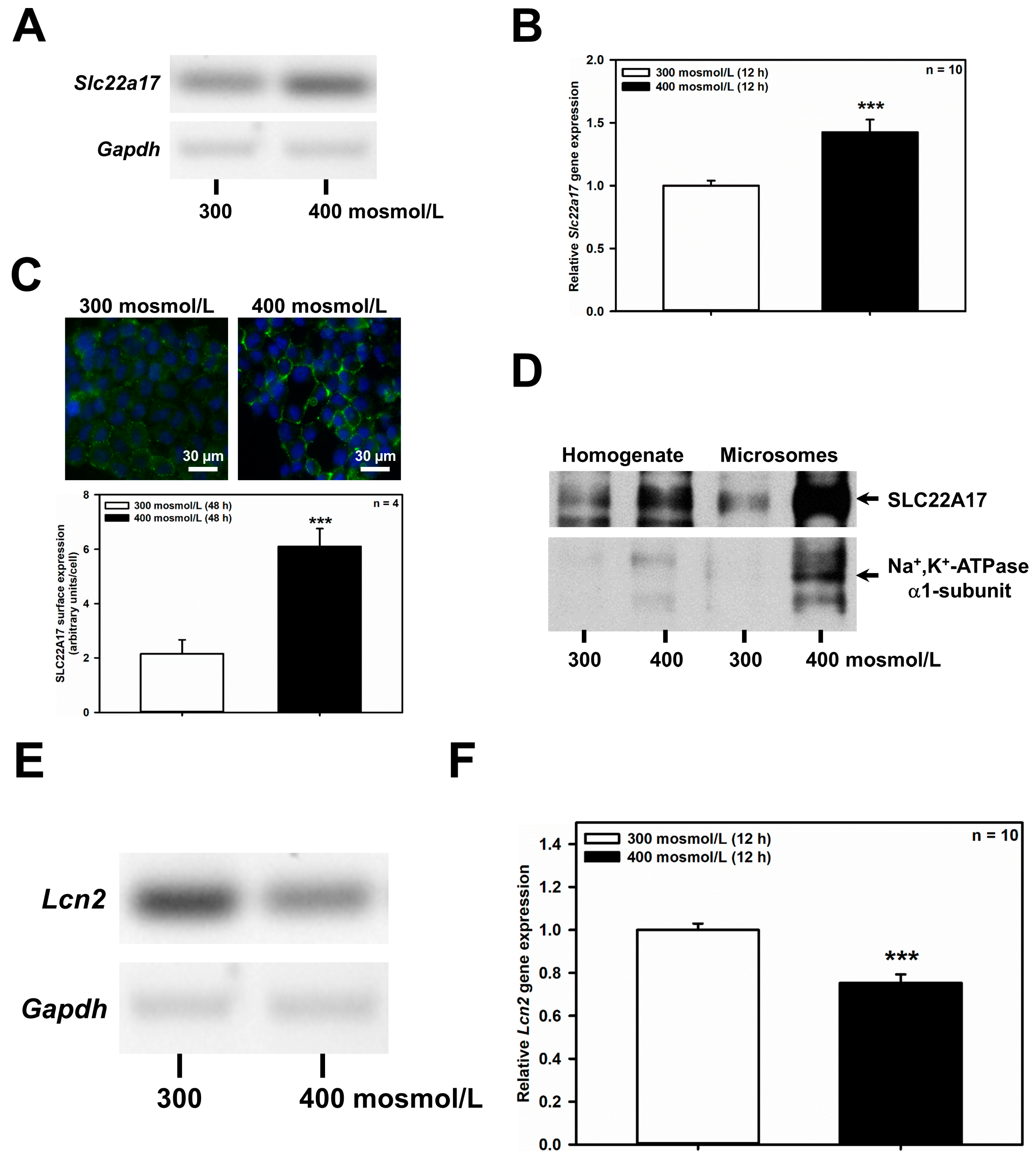
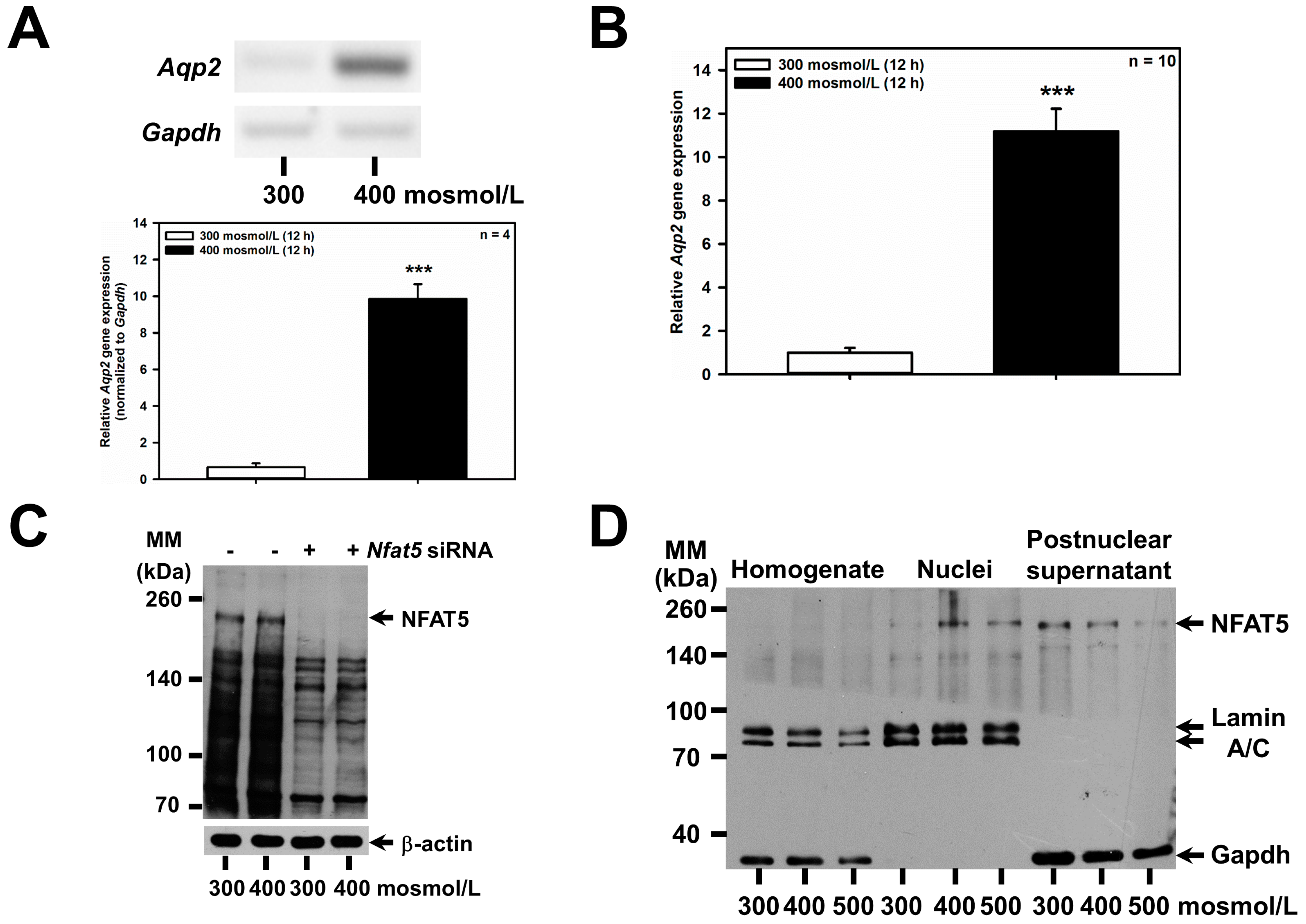
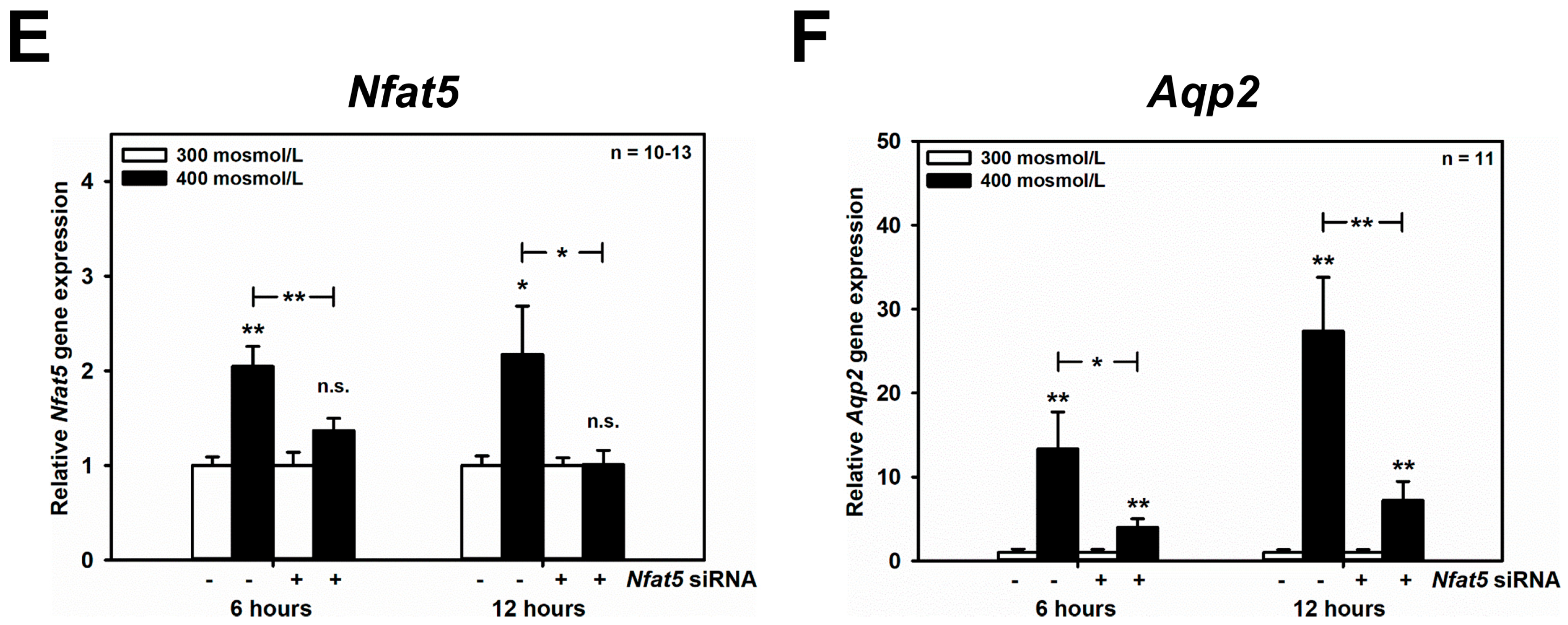

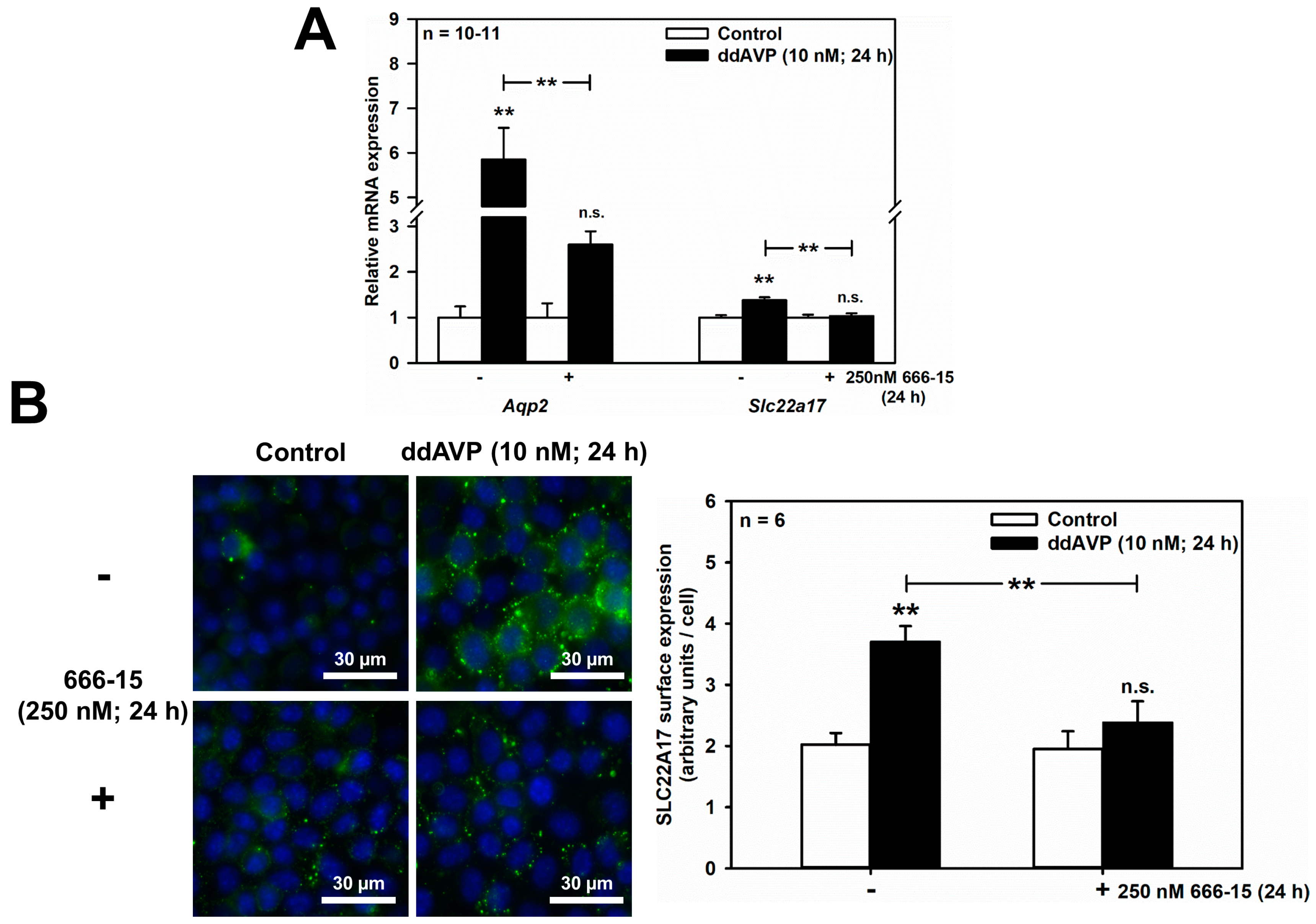

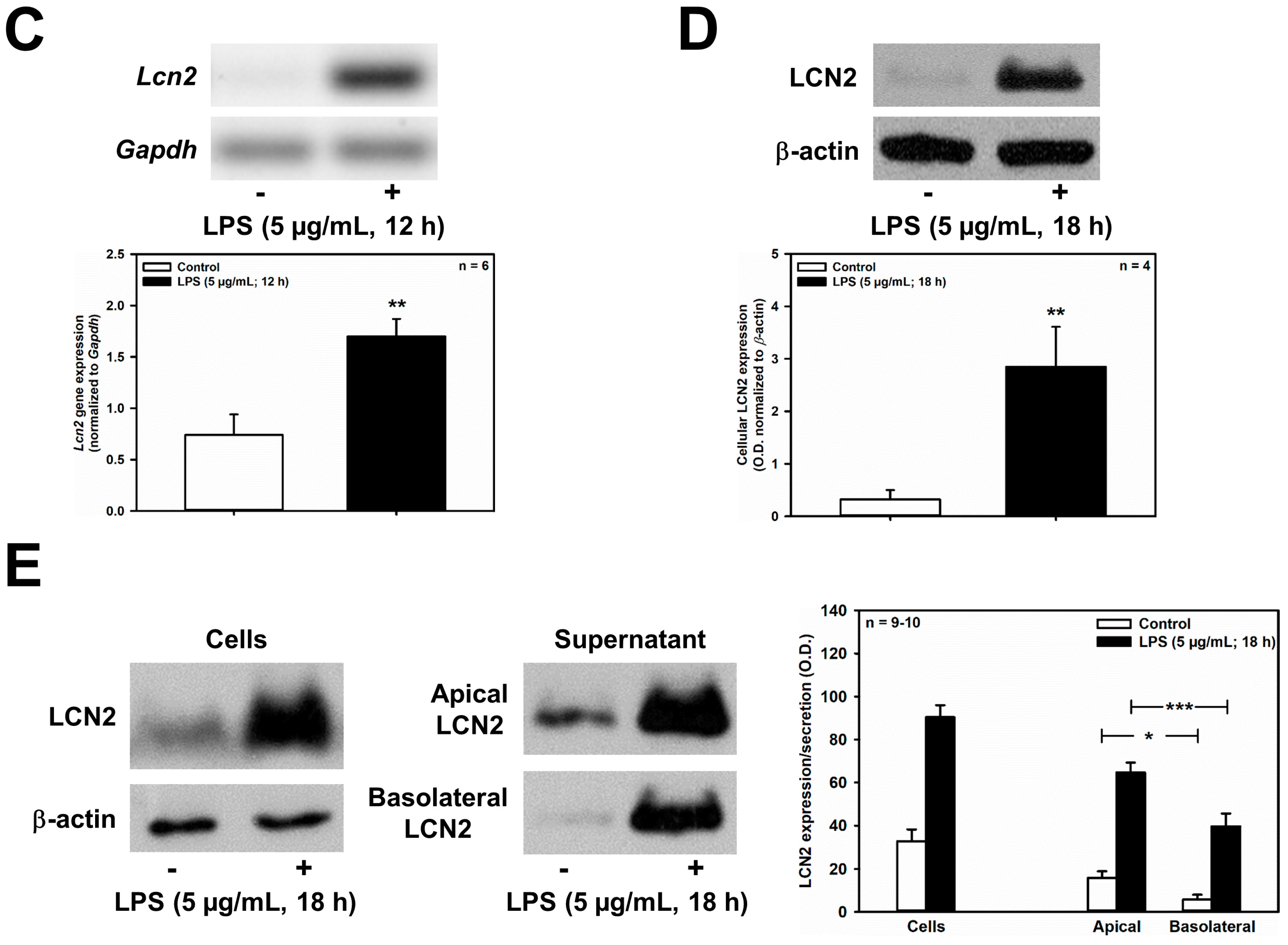
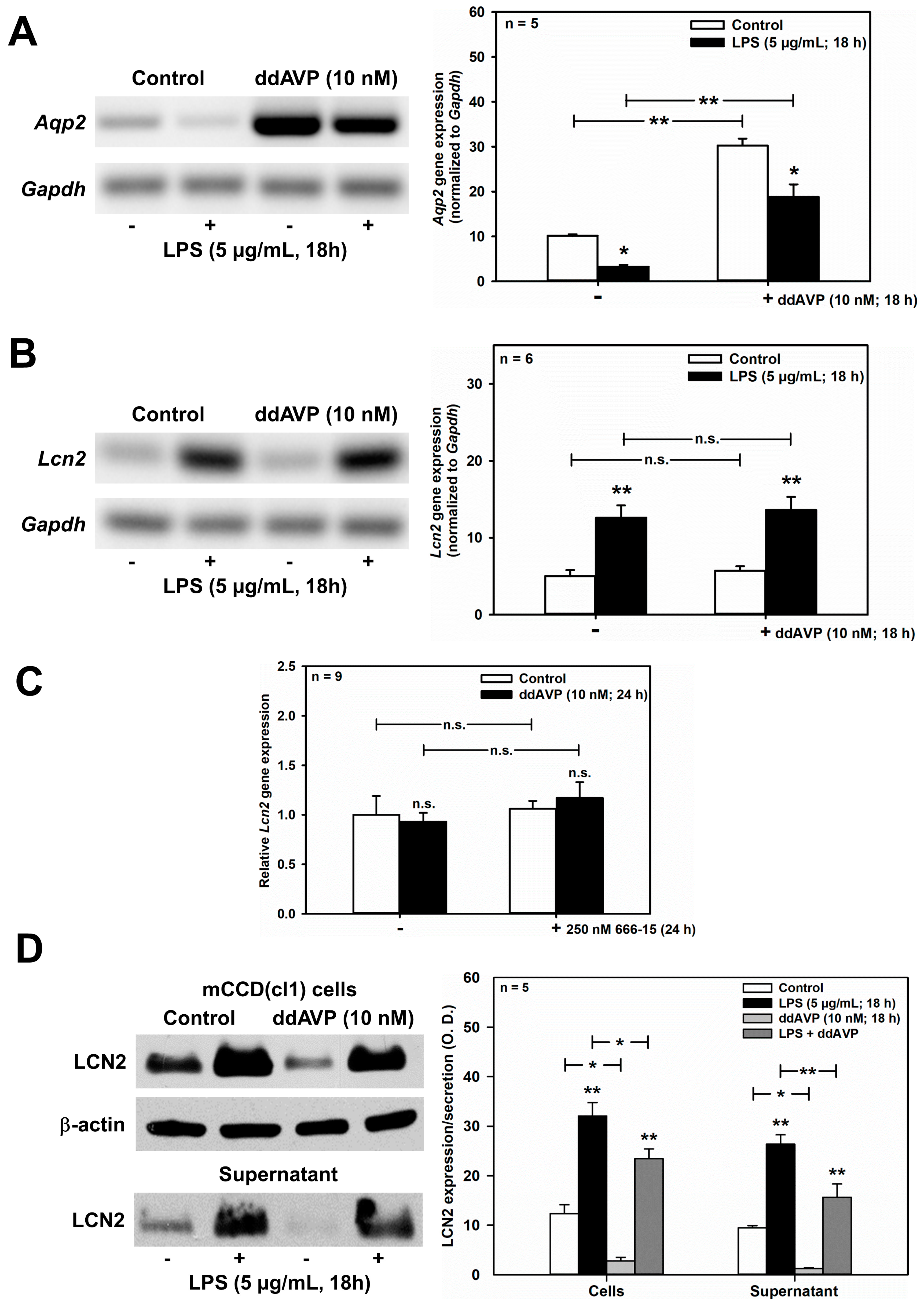

 (red) = inhibition. For further details, see text.
(red) = inhibition. For further details, see text.
 (red) = inhibition. For further details, see text.
(red) = inhibition. For further details, see text.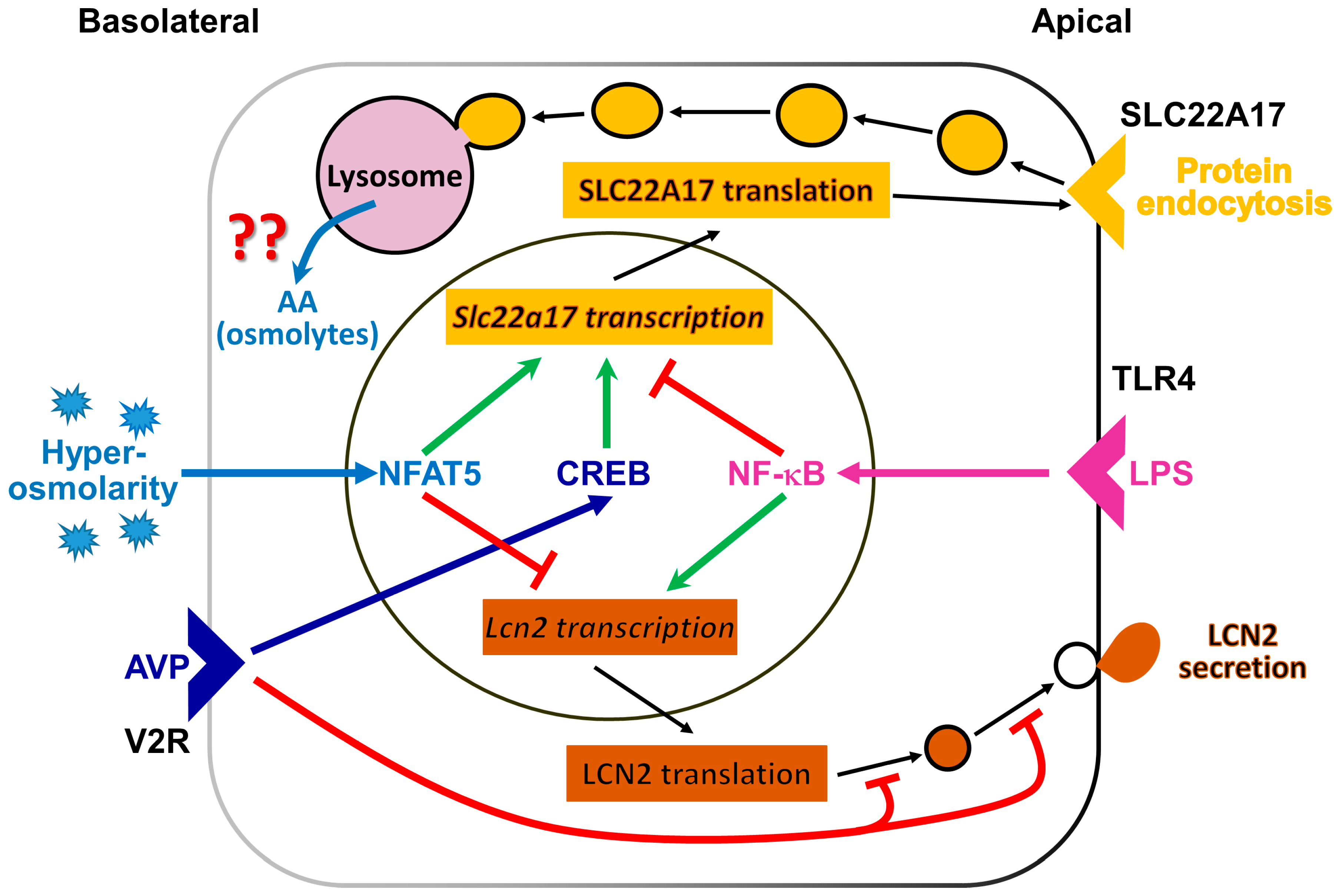
| Immunogen | Host Species | Manufacturer | Catalog # | Application | Dilution |
|---|---|---|---|---|---|
| Rat LCN2 | goat | RD Biosystems | AF3508 | IB * | 1:200–1:300 |
| Mouse LCN2 | rabbit | Abcam | Ab63929 | IF * | 1:250–1:1000 |
| Rat SLC22A17 (C-terminus) | rabbit | [14] | Ig-1086 | IB | 1:100–1:2000 |
| Rat SLC22A17 (N-terminus) | rabbit | [14] | Ig-1095 | IF | 1:100–1:1000 |
| Human b-actin | mouse | [14] | A5316 | IB | 1:20,000 |
| Human GAPDH (14C10) | mouse | Sigma-Aldrich | 2118 | IB | 1:20,000 |
| Human Na+,K+- ATPase a1-subunit | rabbit | Cell Signaling | 3010S | IB | 1:250–1:500 |
| Human Lamin A/C (4C11) | mouse | Cell Signaling | 4777 | IB | 1:20,000 |
| Human NFAT5 | rabbit | [24] | N/A | IB | 1:6000 |
| Human IkB-a | rabbit | Santa Cruz | Sc-371 | IB | 1:1000 |
| Gapdh | Aqp2 | Lcn2 | Slc22a17 | |
|---|---|---|---|---|
| Accession number | NM_001289726.1 | NM_009699.3 | NM_008491.1 | NM_021551.4 |
| Forward primer (5′-3′) | AGGGCTCATGACCACAGT | TGGCTGTCAATGCTCTCCAC | CCACCACGGACTACAACCAG | CAGCCACCTCCTAACCGCTGTG |
| Reverse primer (5′-3′) | TGCAGGGATGATGTTCTG | GGAGCAGCCGGTGAAATAGA | AGCTCCTTGGTTCTTCCATACA | CTCCCACTAGGCTCAAAGGCTGCT |
| Reference | NCBI Primer-BLAST | [53] | [39] | [39] |
| Activation | 5 min 95 °C | 5 min 95 °C | 5 min 95 °C | 5 min 95 °C |
| Cycle number | 18–22 | 31–33 | 20–25 | 27–29 |
| Denaturation | 30 s 94 °C | 30 s 94°C | 30 s 94 °C | 30 s 94 °C |
| Annealing | 30 s 60 °C | 30 s 62 °C | 30 s 60 °C | 30 s 60 °C |
| Extension | 30 s 72 °C | 30 s 72 °C | 30 s 72 °C | 30 s 72 °C |
| Final Extension | 7 min 72 °C | 7 min 72 °C | 7 min 72 °C | 7 min 72 °C |
| PCR product (bp) | 112 | 200 | 100 | 86 |
| Gene-Name (Accession Number) | Forward (5′-3′) | Reverse (5′-3′) | Reference | Amplicon Size (bp) | Efficiency(%) |
|---|---|---|---|---|---|
| Actb (NM_007393.5) | CGTGCGTGACATCAAAGAGAA | GGCCATCTC CTGCTCGAA | [20] | 102 | 102 |
| Gapdh (NM_001289726.1) | CGGCCGCATCTTCTTGTG | CCGACCTTCACCATTTTGTCTAC | [20] | 100 | 100 |
| Lcn2 (NM_008491.1) | CCACCACGGACTACAACCAG | AGCTCCTTGGTTCTTCCATACA | [20] | 98 | 98 |
| Slc22a17 (NM_021551.4) | CAGCCACCTCCTAACCGCTGTG | CTCCCACTAGGCTCAAAGGCTGCT | [20] | 110 | 110 |
| Aqp2 (NM_009699.3) | TGGCTGTCAATGCTCTCCAC | GGAGCAGCCGGTGAAATAGA | [53] | 92 | 92 |
© 2019 by the authors. Licensee MDPI, Basel, Switzerland. This article is an open access article distributed under the terms and conditions of the Creative Commons Attribution (CC BY) license (http://creativecommons.org/licenses/by/4.0/).
Share and Cite
Probst, S.; Scharner, B.; McErlean, R.; Lee, W.-K.; Thévenod, F. Inverse Regulation of Lipocalin-2/24p3 Receptor/SLC22A17 and Lipocalin-2 Expression by Tonicity, NFAT5/TonEBP and Arginine Vasopressin in Mouse Cortical Collecting Duct Cells mCCD(cl.1): Implications for Osmotolerance. Int. J. Mol. Sci. 2019, 20, 5398. https://doi.org/10.3390/ijms20215398
Probst S, Scharner B, McErlean R, Lee W-K, Thévenod F. Inverse Regulation of Lipocalin-2/24p3 Receptor/SLC22A17 and Lipocalin-2 Expression by Tonicity, NFAT5/TonEBP and Arginine Vasopressin in Mouse Cortical Collecting Duct Cells mCCD(cl.1): Implications for Osmotolerance. International Journal of Molecular Sciences. 2019; 20(21):5398. https://doi.org/10.3390/ijms20215398
Chicago/Turabian StyleProbst, Stephanie, Bettina Scharner, Ruairi McErlean, Wing-Kee Lee, and Frank Thévenod. 2019. "Inverse Regulation of Lipocalin-2/24p3 Receptor/SLC22A17 and Lipocalin-2 Expression by Tonicity, NFAT5/TonEBP and Arginine Vasopressin in Mouse Cortical Collecting Duct Cells mCCD(cl.1): Implications for Osmotolerance" International Journal of Molecular Sciences 20, no. 21: 5398. https://doi.org/10.3390/ijms20215398






